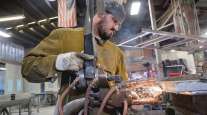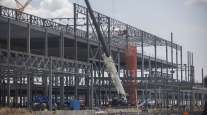How Trump Getting His Way on NAFTA Would Reshape the Auto Sector

Mexico, Canada and the U.S. are at loggerheads after the latest round of NAFTA negotiations, with America’s neighbors rejecting hard-line proposals by the Trump administration that risk throwing automotive trade on the continent into disarray.
President Donald Trump’s proposed changes — including requiring vehicles have 85% NAFTA-sourced parts with half coming from the U.S. to avoid duties in the region — are nonstarters for his two major trading partners. Though more talks are planned for November and into next year, the discussions are slow moving as Mexico and Canada remain unwilling to yield to Trump’s America-First demands.
RELATED: NAFTA deadlock dashes hopes for a quick deal
If the contentious U.S. proposals were to be pushed through, what would the changes mean in real terms to the region’s auto industry? Automakers, analysts and experts weigh in on what scenarios to expect in the unlikely event Washington gets its way.
Automakers Will Probably Still Make Models in Mexico
Today, autos can flow between Canada, Mexico and the U.S. without tariffs as long as they as they are made with 62.5% content from the three nations. By trying to boost that requirement and add a U.S.-specific rule on top, Trump is banking that some of the auto manufacturing jobs that have crossed the borders will return, making the U.S. “the car capital of the world again.”
That may not go as planned. If Trump were to load up NAFTA with new U.S.-focused mandates, carmakers producing in Mexico could simply pay a 2.5% tariff instead to export finished cars to the U.S. That is the rate assessed on U.S. vehicle imports from World Trade Organization countries with Most-Favored Nation status, which both Mexico and Canada have with the U.S. Trump would have to walk away from both NAFTA and the WTO to implement higher tariffs.
Increasing the rules of origin to 85% will make it “very difficult for companies to comply,” said Dan Ikenson, director of the Herbert A. Stiefel Center for Trade Policy Studies at the Cato Institute, a free-market think tank in Washington. “They’re going to have to shift their sourcing around and that means added costs. It gets to the point where it becomes ‘Ah forget it, we can just export’” cars from Mexico and pay the tariff, Ikenson said.
Carmakers May Shift Production Out of North America
Mexico and Canada aren’t the only countries that have Most-Favored Nation status with the U.S. — more than 150 countries fit that bill. China and Eastern European countries like Poland, Slovakia and Slovenia can also export finished cars to the U.S. at the 2.5% tariff, and with low labor costs, they may be appealing to carmakers looking to branch out of North America.
“There will always be someone willing to do the work for less,” said Kristin Dziczek, director of the industry, labor and economics group at the Center for Automotive Research in Ann Arbor, Michigan. “Automakers would just pay the 2.5% tariff rather than put in new plants in the U.S.”
Ford Motor Co., which took heat from Trump on the campaign trail for announcing it would relocate Focus production to Mexico, said this summer it was canceling those controversial plans and would move output to China instead. The move to end North American production of the model entirely brought $1 billion in savings, Ford said.
Right now, the autos that are traded tariff-free through NAFTA have about 70% content from the three countries, according to Center for Automotive Research data. That number could drop if the benefits of NAFTA evaporate or become too costly to enjoy.
Some Truck Production May Return to the U.S.
There are exceptions. While cars like the Focus can be imported into the U.S. from most countries at a 2.5% tariff, light-duty pickups are a different story. Without NAFTA, automakers assembling cars in Mexico and Canada would have to pay the so-called Chicken Tax, a 25% tariff on imported light trucks that has been in place in the U.S. since the 1960s.
For that reason, automakers with a big truck business might be willing to take on the investment cost of revamping supply chains to comply with the steeper requirement, said Ikenson of the Cato Institute.
General Motors Co. and Fiat Chrysler Automobiles NV make full-size pickup trucks in Mexico, though both have announced plans to move some work back to U.S. plants. GM said the week of Trump’s inauguration it would begin to bring axle production for its next-generation full-size pickups to Michigan operations, including work previously done in Mexico, while Fiat Chrysler said that month it would build in the U.S. three new Jeeps and a Ram pickup now made in Mexico. Both companies said the plans were in the works before Trump upped the pressure.
Matt Blunt, president of the American Auto Policy Council, which represents GM, Ford and Chrysler on trade issues, said GM and Chrysler could move all pickup production back to the U.S. — but they might have to push sedan output to Mexico to make room. That would make it a wash in terms of jobs, and would in effect simply add another tax on cars.
“Essentially, if we don’t have a NAFTA or if we have a NAFTA that we can’t use, that’s really a huge tax increase that would undermine our industry or be passed on to consumers,” Blunt said.
Some Components Could Come Back to the U.S.
If Trump gets his NAFTA changes through, some automakers that are already close to achieving the higher rules of origin requirements may opt to relocate some components to the U.S. instead of building new assembly plants altogether.
The easiest way to meet content requirements would be to build engines and transmissions in the U.S., said David Andrea, executive vice president of research at the Center for Automotive Research.
Together, the engine and transmission make up about one third of the value of a car, so making them in the U.S. and shipping them to Mexico for assembly into the finished vehicle would go a long way toward hitting Trump’s proposed targets — while still assembling cars across the border, Andrea said.
It’s a lot to move. Last year, the U.S. imported $12.5 billion worth of engines and transmissions from Mexico and $5.2 billion from Canada, according to the Center for Automotive Research. Only about one third of U.S. engines and engine-parts imports come from outside the region.
Since a new engine plant can cost about $1 billion to build, most companies would likely keep engine production and car assembly in Mexico or Canada and pay the 2.5% rate instead, said Dziczek. Those tariffs will likely end up getting tacked onto the costs of vehicles.
“We do think the proposal that’s out there is counterproductive and harmful,” said Blunt, who represents the Detroit automakers. “Having said that, we recognize that this is a process. This is a negotiation with lots of twists and turns before this is all finished.”
With assistance by Josh Wingrove, and Eric Martin




